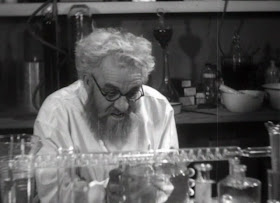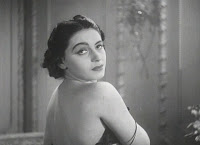In order to get round the codes of film conduct imposed at the time, Maniac is presented as an education piece. An introduction tells us about fear, being a psychic disorder and that it is highly contagious and infectious. We live in an age when unhealthy thoughts creates warped attitudes and in turn create criminals and maniacs. Actually quite wise words, especially in this day and age.
 |
| Maxwell, pre-dating Henry in Eraserhead by many years... |
Dr Meirschultz (Horace Carpenter) is a doctor whose experiments in bringing dead cats back to life is ready to be tested on a human subject - shades of Lovecraft here - so he decides to go to the morgue and collect a subject. He is aided by Don Maxwell (Bill Woods), an ex-vaudeville impressionist who is on the run (we never know what from). Dressed as the coroner, Maxwell and the Dr examine a young female suicide victim, and inject her with the serum the doc has been working on. As she is coming around out of death, they are watched by two embalmers who, it has to be said, are obviously not actors.
The doc wants Maxwell to find a body for him to transplant the heart he has kept alive in a jar, an idea and vision also used in one of my favourite films of all time - Michael Curtiz's Doctor X (1932). When he fails to bring a body in, the doc suggests Maxwell shoot himself so he could bring him back. He is handed the gun, and promptly shoots the doc. He is interrupted by visit from a Mrs. Buckley (Phyllis Diller - NOT the famous one, by the way), who is concerned about her husband who is having hallucinations and is convinced he is the orang-utan killer in Murders In The Rue Morgue - the Bela Lugosi version of the story had been released in 1932 and one of many Edgar Allan Poe nods - and insists the doc sees him. Panicking, and spiralling further and further into madness, Maxwell uses his stage skills and takes place of the dead doc. He injects Mr Buckley with 'super adrenalin' by accident, and he goes 'ape' and abducts the re-animated suicide victim, taking her out into the woods and stripping her.
 |
| Hays code busting boobage! |
The power and deception of being the doc is driving Maxwell more and more insane. He bricks the docs body up in his cellar - more Poe - and, horrified that he is being watched by the doc's cat, Satan, grabs the feline and plucks its eye out - All in view of the camera, I must point out. Then to further cement his madness, eats the eye - "just like an oyster, or a grape!"
Maxwell's wife, on the other hand - a showgirl, who we meet in a changing room with lots of scantily clad girls - has found out the he had a rich uncle who has died and left him a fortune. So she goes to seek him out. Under the heavy influence of paranoia, he believes she wants to him for the money, and that Mrs Buckley wants him to kill her husband. He conspires to get the two women to do away with each other. Trapped in the basement the two women have a screeching cat fight, involving plenty of torn clothes and some quite frankly harsh violence. The police arrive just in time to discover the cackling Maxwell and feuding girls. They are also alerted to the doctor's corpse behind the brick wall by the cat's meow. Maxwell's descent into madness is complete and justice is done.
An exploitation film far above it's reputation, Maniac is ahead of it's time in its depiction of violence and nudity, and some very questionable animal rights issues but for all it's faults it's a striking early horror film. The ultimate mad doctor film maybe. Reoccurring images of fighting cats are interspersed throughout the film - cats with mice, cats fighting cats and cats fighting dogs - which are paralleled with the girl's fight in the cellar at the end, and there's even a strange man who lives next door who breeds cats for their coats! It's worth pointing out for the animal lovers out there the cat that is used in the gouging had already lost it's eye, and is a totally different colour to one used in the scenes leading up to it. However, it does appear that to achieve the cat's 'leaping into frame' shots, they just threw the feline and hoped for the best. Not too bad, I suppose since they are meant to always land on their feet, but doesn't look good to the one that goes into a plate glass display case! Myself, I hate cats (totally allergic to them) but will officially point out I do not condone cruelty to them (but it's fun to watch!)
The film owes more than a nod to Edgar Allan Poe, with at least three of his stories referenced, if inadvertently. The Black Cat is the most obvious, but there are recurring images of eyes, Maxwell becomes convinced the cat, and the women have a 'gleam' in their eyes - a nod maybe to The Tell Tale Heart? - The cat, by the way ends up eating the heart the doctor has beating in the jar! Also, of course the mention of The Murders In The Rue Morgue -a Poe tale. Also, H.P. Lovecraft's Herbert West - Re-animator may well have been the inspiration for the doctor's serum.
Maxwell's decent into madness is often overlaid with stolen images from an obscure Italian silent film, Maciste All'inferno (Maciste In Hell) and there's plenty of stock footage of racing police cars. There are several parts however that are genuinely shocking - the gouging of the cat's eye for one - and some just plain shocking - the acting, and the out of focus camera work. Even the over the top dialogue is entertaining. But for all it's faults, it's an enjoyable 50 minutes of film. Don't let anyone tell you otherwise. It's no Citizen Kane, but it's entertaining, and isn't that what films are meant to be? Esper made movies to make money, like everybody does.Like HG Lewis and the like later, he used exploitation techniques to do so, what's wrong with that? The people wanted to see that sort of thing obviously, and the cheaper he made them, the more he'd make. Good business sense! He also made films exploiting the drug scene (Narcotic, Marihuana - the films spelling, not mine!) and about STDs, Sex Madness (aka They Must Be Told). He is often wrongly assumed to be behind the infamous anti-drug exploitation movie Reefer Madness (originally called Tell Your Children) but he had nothing to do with that, other than being behind it's re-issue - which he also did with Tod Browning's Freaks.
In fact, go over to the internet archive where, as it's public domain, the film is available free.
A fun early exploitation flick, worthy of a better reputation
7 out of 10.
As a footnote, a good warm up for this, and re-create a 1930s grindhouse double bill would be Esper's short "How To Dress In Front Of Your Husband", in which he warns of the perils of peeping toms with cameras as an excuse to watch Elaine Barrie Barrymore (then the wife of screen legend John Barrymore) disrobe. This is contrasted with Trixie Friganza, (who had an uncredited spot in the sound remake of the Lon Chaney classic The Unholy Three) a rather rotund and ungraceful vision, to be fair. Nice and sleazy does it....









No comments:
Post a Comment